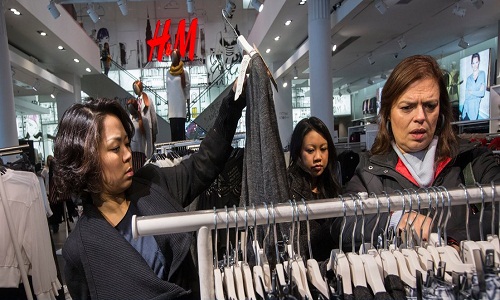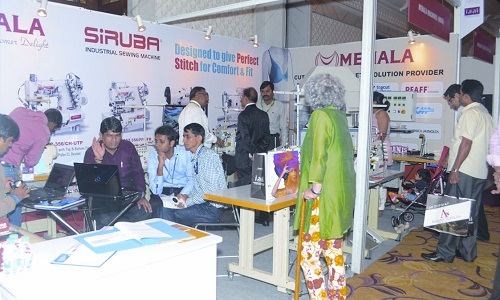FW
A consortium comprising companies and liquidators will keep US teen retailer Aeropostale going and potentially save 229 of its stores. Aeropostale will continue as a business, though with much fewer than the 800 stores it had before it filed for bankruptcy in May amid fierce competition from online retailers, fast fashion trends and the fast-changing tastes of its young clientele. It had been losing money for 13 successive quarters.
The consortium intends to operate at least 229 of Aeropostale’s US stores, in addition to Aeropostale’s e-commerce business and its international licensing business. This way , Aeropostale has avoided bankruptcy liquidation. It hopes to continue to serve customers, emerge with new ownership as a financially stronger company positioned to compete and succeed in an evolving retail landscape apart from preserving thousands of jobs.
New York-based brand is popularly called Aero. It markets accessories and skirts, polos, jeans, hoodies and T-shirts mostly for teenagers. For decades Aeropostale has influenced American teenagers' style and fashion sense. At least five US teen retailers like Pacific Sunwear have filed for bankruptcy in the past two years, as the spending habits of young people shift and they visit malls less often.
"Worldwide, there is a growing sense concern about the quality standard of some of international brands. Of late, quality issues of some of top clothing brands have surfaced out in the open. According to AQSIQ some of the imported industrial products have not qualified the quality measures in June 2016. The products failed to pass the required standards in terms of colour fastness, pH value indicating the presence of excess formaldehyde"

Worldwide, there is a growing sense concern about the quality standard of some of international brands. Of late, quality issues of some of top clothing brands have surfaced out in the open. According to AQSIQ some of the imported industrial products have not qualified the quality measures in June 2016. The products failed to pass the required standards in terms of colour fastness, pH value indicating the presence of excess formaldehyde. As per reports, H&M branded man-made fibres, knitted men's t-shirt imported from Turkey by Haiensimolisi (Shanghai) Commerce had to be destroyed as pH values were high similarly Uniqlo imported men’s denim shirts from Bangladesh, was returned as PH values are not upto the mark. Shockingly, some of the biggest names like Eleven Paris, Levis, Versace, and Topman fall in this list.
Sub standard clothes a health risk
Excess pH values in clothing destroy the acid-base balance, causing skin allergy. It is understood that the garment dyeing and processing process, inevitably get exposed to many chemicals, so a range of pH values is a good barrier to ensure skin health. Because normal human skin pH value is acidic, and can protect the body against infection but in fashion industry pH value is found to be too highly alkaline causing skin irritation, burns, bacteria, etc. Similarly, high formaldehyde content can also stimulate the skin and mucosa, leading to respiratory diseases. It is worth mentioning that, formaldehyde in clothing is also a big problem. Formaldehyde is mainly used for wrinkle, shrink-proofing, color brightness. However, manufacturers are using cheap additives that contain formaldehyde, that result in people wearing them, the chemical is gradually released in the course and may enter the respiratory tract, eyes, and skin thereby causing complications and illnesses.
Since 2011 the national and local government in China has issued import expansion policies for imported clothes and inspection of batches for five consecutive years. However, there is gap in the quality of imported clothing and consumer demand. Hence, quality and safety needs to be improved.
Supply chain management exposes vulnerability
Recently, Giorgio Armani (Shanghai) trading company recall plan was submitted to the State administration for quality supervision. However, the punishment is weak. With China’s economic development and high consumption level, 'fast fashion ' brands in China are being gobbled up. Single regulatory management remains primary means of garment quality control. What's more, can sampling assure quality, fundamentally speaking, it all depends on the fabrics and accessories. Indeed producers have the obligations to subject their products to inspection or entrust a third party inspection, before entering the market.
"For the second year in a row, H&M Foundation has announced one million Euro grant for innovative ideas in sustainable fashion. The foundation’s ‘Global Change Awards’ recognises new initiatives and ideas to challenge the environmental impact of fashion. The H&M Foundation is a non-profit global foundation, privately funded by the Stefan Person family, founders and main owners of H&M."

For the second year in a row, H&M Foundation has announced one million Euro grant for innovative ideas in sustainable fashion. The foundation’s ‘Global Change Awards’ recognises new initiatives and ideas to challenge the environmental impact of fashion. The H&M Foundation is a non-profit global foundation, privately funded by the Stefan Person family, founders and main owners of H&M.
Focus on making fashion industry circular

“The Global Change Award aims to spark ideas that enable products and resour ces to have more than one life. Finding ways to reinvent the fashion industry is a fundamental part of a more sustainable future. Moving towards a circular fashion industry is of immense importance. Even though it’s challenging, it also opens up great opportunities, and makes clear business sense” says Karl-Johan Persson, Board Member of the H&M Foundation and CEO of H&M. Johan goes on to explain innovations that occur as a result of the awards will not be “owned” by H&M, they will be made available to the whole fashion industry. The Global Change Award aims to speed up the transition to a circular business model for the entire fashion industry.
One of the key concepts for this year’s Global Change Awards is ‘making the fashion industry circular’. The ‘circular economy’ is an economic model designed to eliminate waste and restore valuable resources. This applies to all areas of the fashion industry, and to achieve it the fashion industry needs to reinvent itself: how to design, what materials to use, how to dye, cut and sew, ship, sell, own, use and dispose fashion. “New technology, business models and materials can make this possible. By transforming to a circular model, the fashion industry will be able to produce fashion for a growing world population while operating within the planetary boundaries and ensuring a long term viable business,” explains Erik Bang, Project Manager, Global Change Awards.
Comepetition will be over three categories this year: Circular business models, Circular Materials and Circular Processes. While Circular Business Model covers ideas on how to reuse, repair, share, digitalise or extend the life of products, Circular materials will cover ideas on new fibres, recycle techniques, and leather substitutes, etc. Circular processes would find new methods around chemicals, water and dyeing, as well as 3D printing, demand-driven manufacturing, etc.
The Who’s Who in the judges panel
The judges would include David Roberts, Founder of Exponential Leadership & chairman in 1Qbit Information Technologies Inc, Rebecca Earley, Professor in sustainable textile and fashion design at University of the Arts London , Ellis Rubinstein, president and CEO, The New York Academy of Sciences among others
"The fifth edition of Galleria Intima, one of the biggest shows for India’s intimate apparel industry concluded in New Delhi with a massive participation of 200 visitors and more than 500 exhibitors. Organised by Intimate Apparel Association of India, the event covered diverse aspects of the intimate apparel industry, including fabric, laces, fibre, machinery, packaging methodology, design trends, creativity, innovation and accessories. "

The fifth edition of Galleria Intima, one of the biggest shows for India’s intimate apparel industry concluded in New Delhi recently with a massive participation of 200 visitors and more than 500 exhibitors. Organised by Intimate Apparel Association of India (IAAI), the event covered diverse aspects of the intimate apparel industry, including fabric, laces, fibre, machinery, packaging methodology, design trends, creativity, innovation and accessories. The 2016 edition was marked by the presence of government officials, industry professionals, brands, vendors, allied industry players under one roof.
Global players boost industry

IInaugurated by Rashmi Verma, Secretary (Textiles), the Galleria Intima 2016 received a warm response from participants. Verma reiterated the government’s support for the event and lauded the efforts of the IAAI. While welcoming the visitors and exhibitors she explained the idea behind the recent booster offered to the textiles and apparel industry and invited more international participation. Verma stressed upon the growing opportunity for the industry especially in newer markets like the US and Europe. She also focused on the government’s Rs 6,000 crores package for the apparel and textiles industry and upcoming labour reforms and TUF schemes.
Rakesh Grover, President of the IAAI, discussed the problems and concerns ailing the intimate clothing industry and submitted a memorandum asking for the intimate clothing industry to be included in the list of merit goods under the GST bill. Pointing out the role of the association in promoting and expanding the industry he said “This year, we have more than 80 participants from more than 10 countries. This exhibition has more of a Southeast Asian participation. That’s because Southeast Asian countries including China are supplying to the world. In five years, we want to bring the industry to Rs 48,000 crores. Now it’s Rs 24,000 crores. We are working on manufacturing, branding, technology and retail.”
Creativity, innovation the major highlights
Besides bringing forth the latest trends in the industry, the event also addressed the challenges being faced by the intimate clothing industry. It emerged as a key platform for collaboration of talent, skill, business and ideas in the industry. Creativity and innovation were major highlights in the ‘Trends Pavilion’ managed by Professor Monica Gupta and her team from NIFT.
Explaining the event’s growth over the years, Dhiraj Makhija, Makhija Intimates explains, “The show has been growing from strength to strength year on year. The inclusion of new companies from India and abroad, and an array of unique products under one roof are some of the USPs of this show. We get to meet our fellow companies and understand latest trends from the seminars and panel discussions. Going ahead, we would like to see more participation from Indian companies as well as from distributors of companies based overseas to harness better business deals.”
The US government has given approval to duties on imports of a Chinese specialty fabric that allegedly was dumped into the US market, undercutting American-made products at places such as Auburn Manufacturing, industry’s leading expert in the manufacture of high performance textiles for extreme temperature protection. The duties approved by U.S. Department of Commerce will take effect on products that have been imported into the country going back in June at the rate of 162 per cent of the declared value.
This is a really big win, Kathie Leonard, president and CEO of Auburn Manufacturing, said. It shows just how many subsidies have been going to Chinese manufacturers from their government.
US Rep. Bruce Poliquin, who worked with the rest of Maine’s congressional delegation to help Auburn Manufacturing bring its case to the Department of Commerce, said that the preliminary ruling will help create a level playing field for manufacturers.
Poliquin said that China illegally subsidises its manufacturing such that they’re able to sell their products over here and dump their product here. The fact that these duties are so high shows how much these Chinese companies and the government there have violated international law.
Auburn Manufacturing produces amorphous silica fabric, a fireproof material that is used in welding and other manufacturing, and employs about 40 people in Auburn and Mechanic Falls. Chinese dumping has cost the company about 30 % of its market share for the specialty fabric over the last three years and has caused them to cut back the company’s workforce by about 20 per cent over the last year.
India will soon take on the leadership in the global apparel industry by edging out Bangladesh, Vietnam and even China, says Tirupur-based clothes maker T R Vijaya Kumar who owns CBC Fashions. He's a second-generation manufacturer, who's transformed his small family undershirt business employing 1,700 employees into an apparel exporter. His ambitions are even greater, that of tripling exports and adding 500,000 jobs in the process.
According to Kumar, after the cost of production has gone up in China, they are phasing out textile. Naturally, opportunities will go to other countries. It is for us in India to grasp the opportunity. The hindrance is that other Asian nations are way of India in apparel exports. India's $17 billion exports of apparel were about half as much as Bangladesh's last year and its 3.7 per cent global market share lagged behind Vietnam's 5.1 per cent. Narrowing the gap is crucial.
Prime Minister Narendra Modi's biggest failure so far has been the inability to boost employment, says a recent poll. Some time ago, his government had announced a nearly $1 billion package for textile and garment makers, including subsidies for hiring, tax refunds and relaxation of overtime rules with a goal to create 10 million jobs and boost exports by $30 billion in the next three years. ICRA, the local unit of Moody's Investors Service, called the target challenging as demand slows in importing countries.
The Responsible Sourcing Network (RSN), a project of the non-profit company, launched its newest initiative, Yarn Ethically & Sustainably Sourced (YESS). YESS will work to do away with modern-day slavery in cotton harvesting and yarn production by enabling yarn spinners to identify and eliminate cotton produced with forced labour and be verified for having fair labour practices. The development of YESS is supported by Humanity United.
Cotton produced by forced labour documented in at least nine countries according to the US Department of Labour makes its way into clothing and home goods sold by major brands and retailers. This program will pilot in India and Bangladesh, which have numerous spinning mills and are highly affected by forced labour.
Major brands and retailers have endorsed a Statement of Support for this approach including adidas, Hudson’s Bay Company, Indigenous and Woolworths Holdings. YESS will assist companies to comply with new anti-slavery regulations, minimize verification costs, establish an industry-wide traceability approach, and manage a global list of verified spinners. Current multi-stakeholder endorsements are linked here.
YESS is one of just a few initiatives working directly with spinning mills. Located in the middle of the supply chain, spinning mills are uniquely positioned to identify cotton produced with forced labor and prevent it from entering corporate supply chains. This initiative identifies a gap in transparency between where forced labour occurs in the cotton fields and the facilities in which different cottons are blended together. YESS aims to close this gap by focusing on yarn spinning mills in the supply chain, and establishing a training, assessment, and verification process.
As new laws require companies to report on their actions to address modern slavery and human trafficking, more consumers demand ethical manufacturing of their products, and investors increase benchmarking companies against one another on their human rights’ records, YESS will be a vital tool for compliance and responsible sourcing. YESS offers a truly revolutionary approach that will allow apparel brands to identify and root out forced labor from the middle of our supply chains.
According to a sampling of US apparel retailers most have reported lower sales at established stores for the pivotal back-to-school shopping month of August. August is normally a healthy month for US retailers as parents and students line up for back-to-school and even back-to-college shopping, which are a necessity. It is the second-biggest selling period for retailers after the Christmas holiday season.
However, as per National Retail Federation (NRF)'s annual survey earlier last mont, back-to-school shopping was only at the halfway mark despite having started earlier this year. The NRF's annual back-to-school survey showed that parents of K-12 and college students plan to spend a record $75.8 billion this summer denoting an increase of 11.5 per cent over 2015.
The data for August showed US consumer confidence jumped to its highest level in almost a year. The Conference Board said its consumer confidence index jumped to 101.1 in August from a downwardly revised 96.7 in July. Economists had expected the index to come in unchanged compared to the 97.3 originally reported for the previous month. Net sales for the month were $852.9 million, up 3 per cent from $826 million last year.
Milano Unica (MU) launched in 2005 along with Premiere Vision, the fabric fair in Paris, together represent the world’s two most prestigious fabric expositions that attract numerous global textile procurers and purchasers. The upcoming MU 2017A/W to be held from Sepember 6- 8, will move from the central Fiera Milano City to Rho Fiera Milano in the suburbs and the venue will be as big as 60,000 sq. mt. (1.5 times the size of the previous venue). The newly launched MU is being looked upon with great interest, following its relocation, and the focus is on the importance of overall enhanced fashionability. The new system will allow visitors to move freely throughout all zones, including the former entry-restricted Ideabiella zone.
The Japan Observatory (JOB) at Milano Unica celebrates its 5th anniversary this year. Building on the success of each event year-on-year, the JOB has been highly acclaimed by an ever-growing number of repeaters and buyers. Weaving, dyeing and finishing techniques that originated in Japan can be seen in the collective JOB area. While the earlier editions have seen JOB being held in an area far away from the others, it will be integrated in Hall 8 as part of the overall MU structure this year.
Global apparel business expert, Alvanon has appointed May Fong as Senior Consultant for the Asia Pacific region. In her new role, Fong will meet clients from the fashion business clients to identify their brand-building and business-growth challenges. By this, she would explain Alvanon’s technical and advisory capabilities and offer customized best practice solutions. The announcement was made by Alvanon’s Executive Director Don Howard.
Howard says, Alvanon’s existing and prospective clients throughout the Asia Pacific arena will benefit from Fong’s proven ability to anticipate, recognize and address their most intricate of fashion business concerns. Moreover she is fluent in Cantonese, Mandarin, Japanese and English, which will allow her to coordinate planning among fashion businesses that interact across Asia Pacific, Europe and the United States.
Fong comes to Alvanon from Lacoste Asia Pacific where she served as Senior Regional Product Manager. She holds a Master of Management from the Macquarie Graduate School of Management, Australia and a Bachelor of Arts in Japanese Studies from the Chinese University of Hong Kong.












